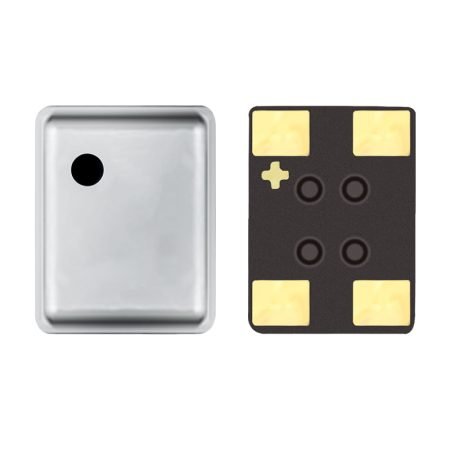كتالوج
Warm-up drift occurs when pressure sensors transition from cold start to operating temperature, causing output instability. In critical applications like medical ventilators and neonatal monitoring equipment, even minor drift affects patient safety. Traditional piezoresistive sensors consist of silicon diaphragms and four piezoresistive elements configured in Wheatstone bridges. When powered, resistive heating creates temperature gradients, causing signal drift until thermal equilibrium establishes.
1. Sensor Element Thermal Effect Control
Reducing Excitation Voltage Impact
Piezoresistive element temperature rise follows a quadratic relationship with excitation voltage (ΔT∝V²). Reducing voltage by 50% decreases temperature rise by 75%, significantly lowering warm-up drift. Though signal strength decreases proportionally, the net effect still halves the drift. However, lower voltage increases system noise, requiring balance between signal-to-noise ratio and drift performance.
Pulsed Power Supply Technology
Implement intermittent power supply based on system bandwidth requirements, energizing sensors only during measurements. For example, a device sampling every 500ms with 4ms settling time and 1ms acquisition time uses only 1% average power compared to continuous operation. This method dramatically reduces heat accumulation and suppresses warm-up drift effectively.

2. Temperature Compensation Strategy Optimization
Eliminating Temperature Gradient Issues
Traditional dual-sensor systems create temperature gradients between external temperature sensors and pressure sensor diaphragms. The gradient stabilization process appears as warm-up drift. A more effective approach uses the pressure sensor’s own resistance temperature coefficient, employing bridge resistance directly as temperature sensing elements, eliminating spatial temperature differences.
Self-Compensation Circuit Design
Utilizing the positive temperature coefficient of sensor bridges, monitoring voltage shows negative changes with temperature increases. Comparing this change with reference voltage accurately provides sensor temperature information. System electronics perform real-time calibration based on this data, eliminating external sensor lag effects through fast-response self-compensation mechanisms.
3. Structural Design Improvements
Thermal Isolation Technology
Introduce thermal isolation structures in sensor packaging to reduce environmental temperature impact on sensitive elements. Use low thermal conductivity materials as isolation layers with optimized thermal path design. Proper PCB layout keeps heating components away from sensor areas, significantly improving thermal stability and reducing warm-up time.
Material Property Optimization
Select material combinations with matched thermal expansion coefficients to reduce temperature-induced stress changes. Thermal matching between silicon diaphragms and packaging materials directly affects sensor temperature stability. Stress-relief designs and low-stress packaging processes further enhance output stability during temperature variations.
4. System-Level Control Technology
Preheating and Pre-conditioning
Implement preheating strategies in critical applications, briefly heating sensors before formal measurements to quickly reach operating temperature. This method suits intermittent operation equipment. Preheating power and duration require precise calculation based on sensor thermal time constants to avoid overheating damage to sensitive elements.
Dynamic Calibration Algorithms
Develop intelligent calibration algorithms monitoring sensor output trends in real-time, identifying warm-up drift patterns. Establishing drift compensation models enables software-level signal correction. This approach combines hardware optimization with software processing advantages, providing additional assurance for high-precision applications.
5. Practical Application Verification
Medical Device Applications
In ventilators and monitoring equipment, combining pulsed power supply with self-temperature compensation reduces warm-up drift to within ±0.1%FS. Testing shows optimized sensors achieve long-term stability accuracy within 30 seconds, meeting strict medical device requirements. These performance improvements significantly impact patient monitoring accuracy and safety.
Industrial Process Control
In industrial automation, comprehensively optimized pressure sensors maintain stable performance under harsh conditions. Temperature shock test results show drift recovery time reduced by over 60%, substantially improving production line startup efficiency and product quality stability.
خاتمة
Minimizing pressure sensor warm-up drift requires coordinated improvements across multiple dimensions. Power management reduces heat generation through lower excitation voltage and pulsed supply; temperature compensation uses self-compensation technology eliminating gradients; structural design emphasizes thermal isolation and material matching; system control combines preheating with dynamic calibration algorithms. Comprehensive application of these technologies controls warm-up drift within acceptable ranges, ensuring reliable sensor performance across various applications. For high-precision applications, combination approaches deliver optimal drift control effectiveness.
The above introduction only scratches the surface of the applications of pressure sensor technology. We will continue to explore the different types of sensor elements used in various products, how they work, and their advantages and disadvantages. If you’d like more detail on what’s discussed here, you can check out the related content later in this guide. If you are pressed for time, you can also click here to download the details of this guides منتجات استشعار ضغط الهواء PDF بيانات.
For more information on other sensor technologies, please قم بزيارة صفحة أجهزة الاستشعار لدينا.
